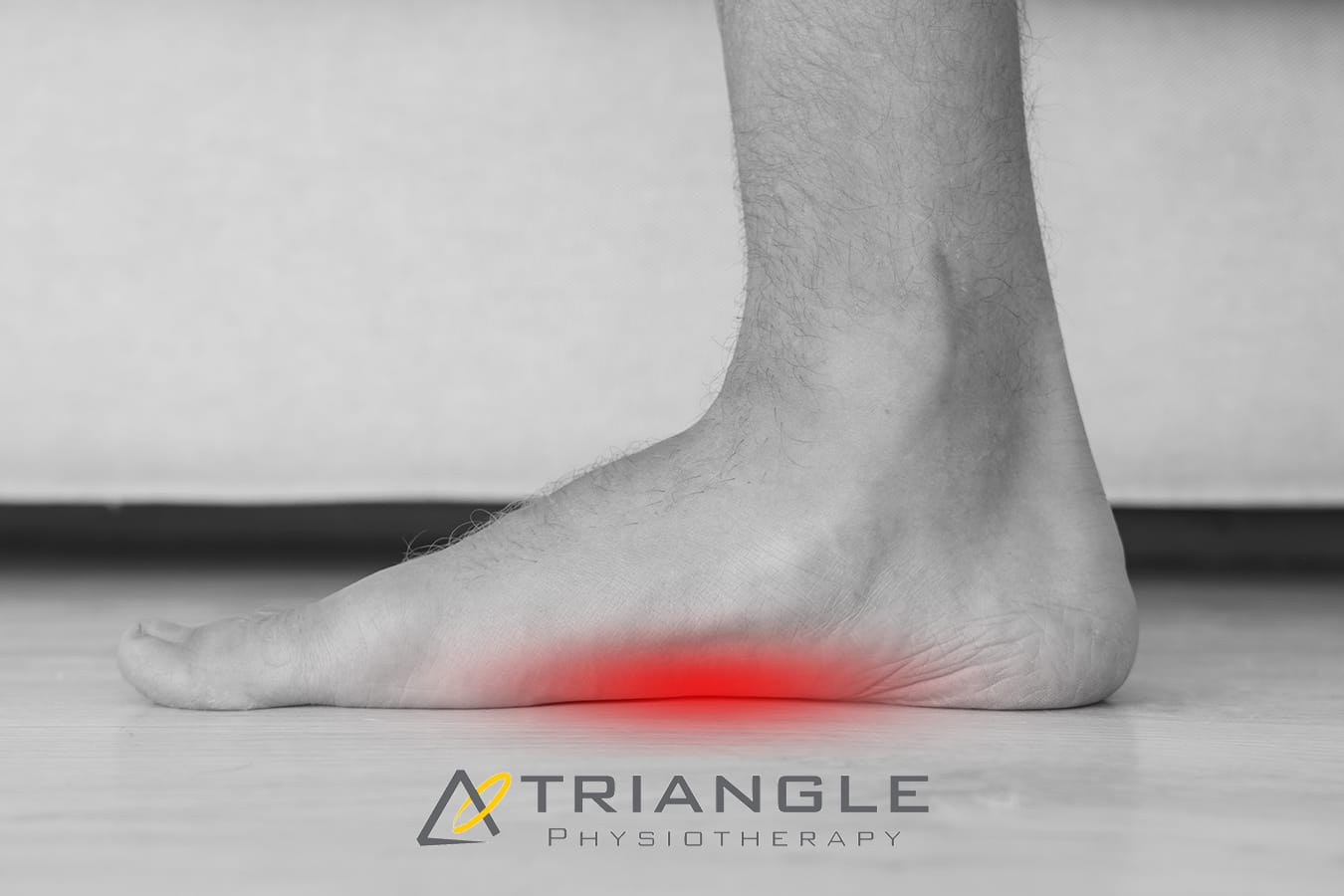Recovering from orthopedic surgery is a crucial phase that sets the foundation for long-term mobility and quality of life. While surgery is a significant step toward healing, the recovery process often requires dedicated effort and guidance. This is where physiotherapy plays a vital role, helping patients regain strength, flexibility, and overall function. Triangle Physiotherapy can help you with your recovery journey post-surgery and safely transition back into your daily activities and sports.
Understanding Recovery from Surgery
Post-operative recovery involves more than just healing the surgical site; it encompasses rebuilding strength, restoring movement, and managing pain. Many patients face challenges like stiffness, weakness, and discomfort during this phase. Physiotherapy provides a structured approach to recovery, focusing on individualized treatment plans tailored to each patient’s specific needs. Engaging in physiotherapy early can significantly enhance recovery outcomes.
Neuromuscular Exercises for Recovery after Surgery
Neuromuscular exercises are designed to improve muscle coordination, strength, and balance. These exercises are particularly important after orthopedic surgery, as they help re-educate the muscles surrounding the surgical area. Examples include balance exercises, proprioceptive training, and targeted movements that activate specific muscle groups. By strengthening these muscles, patients can alleviate pain and improve stability, reducing the risk of future injuries.
Mobility Incorporation
Maintaining mobility is crucial during the recovery process. Physiotherapists incorporate mobility exercises, such as stretching and gentle range-of-motion activities, to help patients regain flexibility and prevent stiffness. Activities like yoga or tai chi may also be recommended, as they promote relaxation and enhance overall well-being. Incorporating mobility into daily routines not only aids in recovery but also encourages a healthier lifestyle.
Progressive Resistance Exercises
As recovery progresses, progressive resistance exercises become essential. These exercises gradually increase the intensity of strength training, allowing patients to build endurance and strength safely. Utilizing resistance bands, weights, or bodyweight, physiotherapists design programs that align with each patient’s recovery stage. This gradual approach ensures that patients do not overexert themselves while still making meaningful gains.
Prevention
Preventing future injuries is a significant aspect of post-operative care. Physiotherapists educate patients on proper body mechanics, ergonomics, and strategies to avoid movements that could lead to re-injury. By addressing risk factors and instilling healthy habits, patients can enhance their resilience and reduce the likelihood of setbacks.
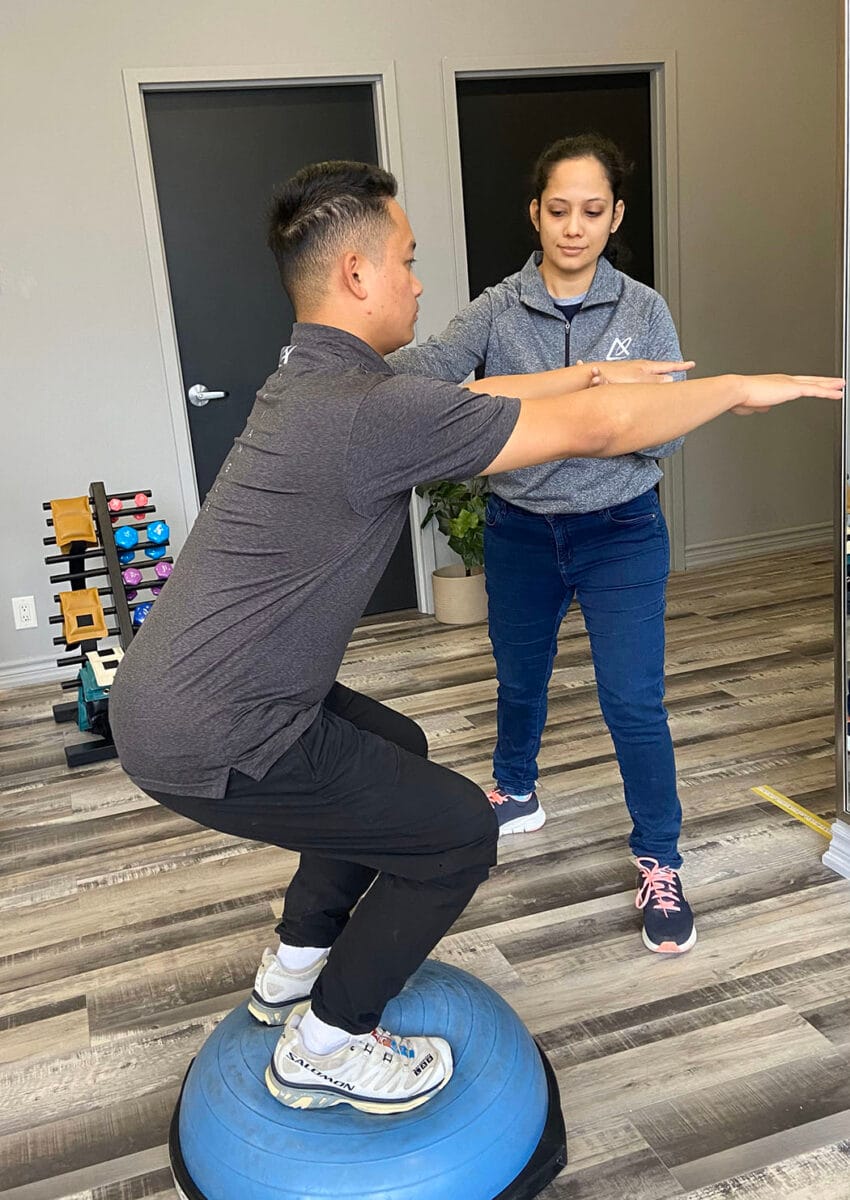
FAQs
Can a physiotherapist help with my recovery?
Absolutely! Physiotherapists specialize in rehabilitation, offering tailored exercises and strategies to facilitate recovery from surgery.
What should I expect during my first visit to Triangle Physiotherapy?
During your first visit, you’ll undergo a thorough assessment where your physiotherapist will evaluate your condition, review your medical history, and discuss your recovery goals. A personalized treatment plan will be created based on this information.
How many sessions will I need?
The number of sessions varies based on your specific surgery and recovery progress. Some patients may see improvement in a few sessions, while others might require ongoing therapy. Your physiotherapist will provide an estimate during your assessment.
Do I need a referral to see a physiotherapist?
No, you do not need a referral to access physiotherapy services. You can book an appointment directly, unless your insurance requires it for billing purposes.
How soon can I expect pain relief?
Many patients report improvements within a few sessions, but the timeline can vary depending on individual circumstances and the nature of the surgery.
How can I ensure a smooth recovery?
Engaging in physiotherapy, following your rehabilitation plan, and incorporating exercises into your daily routine are essential for a successful recovery. Listening to your body and communicating with your physiotherapist will also help you stay on track.
Learn More About Pre and Post-Surgery Physiotherapy at Triangle Physiotherapy
Physiotherapy is integral to post-orthopedic surgery recovery. By understanding the recovery process, incorporating targeted exercises, and prioritizing prevention, patients can regain their independence and improve their quality of life. If you’re preparing for surgery or currently in recovery, consider the invaluable support that physiotherapy can offer.
If you would like to know more about how we can help you with your pre or post-surgery rehab, call us to schedule an initial assessment today!
Pregnancy is an incredible journey, but it can also bring a variety of physical changes and challenges. One of the best ways to support your body during this time is by seeing a pelvic health physiotherapist.
The good news is that the pelvic health physiotherapists at Triangle Physiotherapy are experienced and trained to help you to smoothly navigate your pregnancy journey.
Here are eight compelling reasons to consider this specialized care throughout your pregnancy.
1. Alleviate Discomfort and Pain

Pregnancy can lead to discomfort and pain in various areas, particularly the lower back, hips, and pelvis. A pelvic health physiotherapist can assess your posture, movement patterns, and muscle imbalances. They can provide targeted exercises and techniques to relieve pain, helping you feel more comfortable as your body changes.
2. Improve Core and Pelvic Floor Strength
Strong core and pelvic floor muscles are essential during pregnancy. A pelvic health physiotherapist can guide you through safe exercises that strengthen these areas, preparing your body for the physical demands of labor and delivery. This foundation can also help reduce the risk of complications during childbirth.
3. Enhance Posture and Body Mechanics
As your pregnancy progresses, your center of gravity shifts, often leading to changes in posture. Poor posture can contribute to discomfort and pain. A pelvic health physiotherapist can teach you proper body mechanics and alignment strategies, helping you maintain good posture throughout your pregnancy and beyond.
4. Manage Incontinence Issues
Many pregnant women experience urinary incontinence due to the added pressure on the bladder and hormonal changes. A pelvic health physiotherapist specializes in pelvic floor dysfunction and can provide exercises to strengthen the pelvic floor, helping to manage and reduce incontinence issues during and after pregnancy.
5. Prepare for Labor and Delivery
A pelvic health physiotherapist can help you prepare your body for labor and delivery through specific exercises and techniques. They can teach you breathing strategies, positions for labor, and relaxation techniques, empowering you with tools to facilitate a smoother birthing experience.
6. Support Postpartum Recovery
While the focus is often on pregnancy, the postpartum period is equally important. A pelvic health physiotherapist can help you transition back to your pre-pregnancy activities by addressing any lingering pain, pelvic floor dysfunction, or core weakness. Early intervention can lead to better recovery and long-term health.
7. Educate on Body Changes
Understanding the physical changes your body undergoes during pregnancy can be incredibly empowering. A pelvic health physiotherapist provides education on what to expect, including changes to your pelvic floor and core muscles. This knowledge can help alleviate fears and build confidence as you navigate your pregnancy and postpartum recovery.
8. Personalized Care and Support
Every pregnancy is unique, and a pelvic health physiotherapist offers personalized care tailored to your specific needs. They take the time to understand your individual concerns, lifestyle, and goals, ensuring that you receive the most effective treatment. This supportive environment fosters trust and encourages open communication about any issues you may encounter.
Book Your Appointment Today!
Seeing a pelvic health physiotherapist is a very important part of your pregnancy journey. Book your appointment as soon as you have confirmation of your pregnancy to make sure you have a supportive healthcare practitioner alongside you to guide you through this new and exciting phase in your life.
Triangle Physiotherapy has eight locations in the GTA offering pelvic health physiotherapy. Call us today!
Ref: https://pelvichealthsolutions.ca/knowledge-base/pregnancy
Concussions are common head injuries that can result from falls, sports accidents, or other trauma to the head. They disrupt normal brain function and may cause symptoms like headaches, dizziness, confusion, and fatigue. While conventional medicine often focuses on rest and symptom management, many people are now looking into natural, holistic methods to support recovery. One approach people consider is seeking the help of a naturopath.
What is a naturopath, and how do they approach health care?
A naturopath is a healthcare practitioner who uses natural remedies and holistic approaches to promote healing and overall well-being. Instead of focusing solely on symptoms, naturopaths work to address the root causes of illness and injury, considering lifestyle, diet, and mental health as part of the healing process. They often use a combination of natural therapies, including:
- Natural Medicine: Using plant-based remedies to support the body’s healing process.
- Nutritional Counseling: Recommending specific foods and supplements to boost recovery.
- Homeopathy: Treating injuries with highly diluted natural substances that trigger the body’s self-healing abilities.
- Lifestyle Modifications: Encouraging stress reduction, adequate rest, and gradual return to activity.
When dealing with concussions, a naturopath’s goal is to enhance the body’s natural healing abilities and reduce inflammation to promote brain recovery.
What is a Concussion?
Concussions are caused by an impact to the head or body that is associated with a mild traumatic brain injury that affects brain function. Effects are often short term and can include headaches and trouble with concentration, memory, balance, and sleep.

What is Post-Concussion Syndrome?
Symptoms of a mild traumatic brain injury can persist long after an injury. These symptoms may include headaches, dizziness, and problems with mood, concentration and memory. These symptoms can be improved with lifestyle adjustments, proper nutrition, stress management and supplements.
How doe Naturopaths approach Concussion Management
Naturopathic Medicine approaches concussion injuries from several modalities, and generally an ND will use which ever avenues of care are most appropriate for the individual.
1) Stress Management
Working with an ND to discuss how to remove or lessen stressors in your life can be a major benefit. Although some stressors are unavoidable, an ND can offer structured guidance on managing stress. Working to increase the quantity and quality of regenerative sleep, for example, is key for a healthy recovery. Breathing exercises are commonly taught to concussion patients as it gives them a practical means to regulate their stress and symptoms on their own.
2) Physical Activity
Discussing a gentle exercise routine, even if it’s just a daily short walk, can lead to much better outcomes in the long run. Gentle physical activity can relieve stress and offer great benefits to metabolic health. It can also offer an easy start to incorporate exercise into a person’s life whootherwise wouldn’t know where to start. Once the recovery process is underway, the exercise quantity and intensity can be slowly increased to return increased benefit.
3) Acupuncture
Acupuncture is a painless dynamic therapy that can offer many benefits to a concussion patient. The effects can be roughly divided into physical and psychological. Acupuncture can increase circulation, reduce inflammation, relax tense muscles & joints, and lessen pain. It can also be utilized to regulate a person’s sympathetic (stress) response, calm the mind, and offer relief from stress & anxiety and to help manage sleep.
4) Dietary Nutrition
A poor diet can throw off the mood and quality of life of anyone, however this is especially true for a person recovering from a concussion. An emphasis on a healthy diet is key to minimizing disruptive symptoms and accelerating recovery. In some cases, specific types of diets can be utilized to address the prevalence of certain symptoms and problems.
5) Supplementation
Natural health products can be expertly utilized by a qualified naturopathic doctor to address a wide range of concerns and ultimately to increase quality of life and speed up the recovery process. If needed, an ND may run bloodwork to look for specific markers related to the patients injury and general health. This information can be used to direct administration of supplements and to monitor progress.
Are naturopathic treatments safe for concussion recovery?Yes, naturopathic treatments are generally safe when administered by a qualified practitioner. However, it is important to have an integrative approach when recovering from a concussion. This means working with both conventional medical doctors and a naturopath to ensure that you are getting comprehensive care.It’s crucial to remember that naturopathic treatments should complement—not replace—medical care, especially if there are serious or worsening symptoms such as loss of consciousness, severe headaches, or prolonged confusion.
Naturopathic medicine offers a complementary and holistic approach to concussion recovery. While conventional medicine plays a crucial role in diagnosing and managing concussions, naturopaths focus on supporting the body’s natural healing processes with a combination of herbal remedies, nutrition, and lifestyle adjustments. By working alongside traditional healthcare providers, naturopaths can help individuals manage their symptoms, improve their brain health, and potentially speed up recovery.
If you’ve suffered a concussion, consider consulting a naturopath to explore natural ways to support your healing journey—just make sure to keep your healthcare provider informed and work with them to find the right balance of care.
Our Naturopath in Etobicoke, Dr. David Gabriele can help you recover from the lingering effects of a concussion. Book your appointment today!
Living an active lifestyle is crucial for our overall health and well-being. It’s not just about hitting the gym; it’s about integrating movement into your daily life. Whether you’re looking to enhance your mobility or recover from an injury, physiotherapy in Oakville can play a key role in helping you stay active. Here are seven tips that can help you embrace a more active lifestyle, focusing on various exercise types, prevention strategies, and the importance of physiotherapy.

1. Embrace Neuromuscular Exercises
Neuromuscular exercises are all about improving your body’s ability to perform coordinated movements. Think of activities like yoga, Pilates, or tai chi. These exercises enhance balance, agility, and coordination, which are essential for daily activities and overall mobility.
Start by incorporating short sessions into your routine. Even 15 minutes of yoga in the morning can make a difference. If you’re in Oakville, you can consult a physiotherapist to ensure your movements are precise and safe, helping you avoid injury. As you become more comfortable, explore different styles or join a class to keep things exciting.
2. Incorporate Progressive Resistance Exercises
Progressive resistance exercises are crucial for building strength and endurance. These exercises involve gradually increasing the amount of weight or resistance you use, helping your muscles adapt and grow stronger over time.
You don’t need a gym membership to do this. Bodyweight exercises like push-ups, squats, and lunges can be done anywhere. For those in Oakville looking to enhance their routine, physiotherapy can offer personalized advice on proper technique, especially if you’re recovering from an injury or have muscle imbalances. Aim for two to three sessions per week, focusing on major muscle groups for balanced strength development.
3. Prioritize Mobility Exercises
Mobility exercises enhance your range of motion and flexibility, reducing the risk of injury. Think dynamic stretches or mobility drills that prepare your body for movement.
Integrate these exercises into your warm-up routine before any physical activity. Simple movements like arm circles, hip openers, and ankle rolls can improve your mobility significantly. If you’re looking for guidance, physiotherapy in Oakville can assist in identifying areas of stiffness or restricted movement and provide tailored exercises to improve your flexibility.
Good mobility isn’t just for athletes; it’s essential for everyone. It helps with daily tasks like bending down to tie your shoes or reaching for items on high shelves.
4. Focus on Prevention
Incorporating preventative measures into your active lifestyle is key. This includes listening to your body and recognizing signs of overexertion or fatigue. Stretching before and after exercise can help reduce muscle tension and soreness.
If you are in Oakville, regular visits to a physiotherapist can help you prevent injuries before they happen. They can evaluate your movement patterns and suggest exercises that align with your fitness goals while minimizing the risk of injury. Prevention is always better than cure, so pay attention to your body’s signals and adapt your routine accordingly.
5. Understand the Importance of Physiotherapy
Physiotherapy plays a vital role in maintaining an active lifestyle, especially if you’ve had past injuries or chronic pain. A physiotherapist can assess your movement patterns, identify weaknesses, and design a tailored exercise program to help you improve.
If you’re in Oakville, a local physiotherapy clinic can provide valuable insights even when you feel fine. Consulting a professional early on can help you develop a balanced routine that enhances your strength and mobility, reducing your risk of injury in the long run.
6. Tips for Safely Performing Exercises
Safety should always be a priority when exercising. Here are some tips to ensure you stay injury-free:
- Warm Up and Cool Down: Spend at least five to ten minutes warming up before any workout and cooling down afterward.
- Focus on Form: Proper form is essential to prevent injuries. If you’re unsure, don’t hesitate to ask for guidance or watch instructional videos. Better yet, seek advice from a physiotherapist in Oakville to ensure you’re doing exercises correctly.
- Start Slow: If you’re new to a type of exercise, ease into it. Gradually increase intensity and duration as your body adapts.
- Stay Hydrated: Dehydration can lead to fatigue and injuries, so drink plenty of water before, during, and after exercise.
7. Make Movement a Daily Habit
Lastly, find ways to incorporate more movement into your daily routine. Take the stairs instead of the elevator, walk or bike for short errands, or even set a timer to remind you to stretch or take a quick walk every hour.
If you’re based in Oakville, there are various local parks and trails where you can get moving outdoors. Additionally, a physiotherapy consultation can help you find creative ways to integrate movement into your routine, especially if you’re dealing with mobility limitations.
The key is to make movement enjoyable. Try different activities until you find what you love, and remember that every little bit counts!
Check out this article on the Concept of Wellness.

Headaches and migraines are common conditions that can significantly impact quality of life. For many people, these conditions can become chronic, leading to frequent discomfort and reduced quality of life. While medication may provide temporary relief, it often doesn’t address the underlying causes of the pain. This is where physiotherapy comes in. Specifically, those in Etobicoke can benefit from a comprehensive, holistic approach to managing headaches and migraines through physiotherapy.
Understanding the Root Causes of Headaches and Migraines
Headaches and migraines can arise from various factors, including:
- Muscle Tension: Chronic muscle tension in the neck, shoulders, and jaw can contribute to headaches.
- Poor Posture: Poor posture can lead to misalignment of the spine, straining muscles and nerves.
- Stress and Anxiety: Emotional stress can trigger or exacerbate headaches.
- Temporomandibular Joint (TMJ) Disorder: Problems with the jaw joint can cause headaches and facial pain.

How Physiotherapy Can Help
1. Postural Correction
Many headaches are caused by poor posture, particularly when sitting for long periods. Physiotherapists in Etobicoke work on posture correction, educating patients on proper alignment and offering exercises to strengthen muscles that support a healthy posture.
2. Manual Therapy
Manual therapy techniques, such as soft tissue massage, joint mobilizations, and trigger point therapy, can help release muscle tension and improve mobility in the neck and shoulders, reducing the frequency and intensity of headaches.
3. Cervical Spine Alignment
Misalignment in the cervical spine can contribute to headaches and migraines. Physiotherapists in Etobicoke can assess the spine and provide treatments to realign vertebrae, decreasing nerve irritation and reducing headaches.
4. Stress Management Techniques
Stress is a common trigger for both headaches and migraines. Physiotherapy includes relaxation techniques, breathing exercises, and even guided stretches that help reduce stress, promoting relaxation and decreasing the likelihood of headache onset.
5. Exercise Prescription
Targeted exercises strengthen the muscles of the neck, shoulders, and upper back, helping patients develop a more resilient posture and reducing muscle tension that can lead to headaches. Home exercise programs are often prescribed to maintain these benefits between sessions.\
6. Dry Needling
This technique involves inserting thin needles into trigger points, which are areas of muscle tension or knots. Dry needling can help reduce pain and improve muscle function.
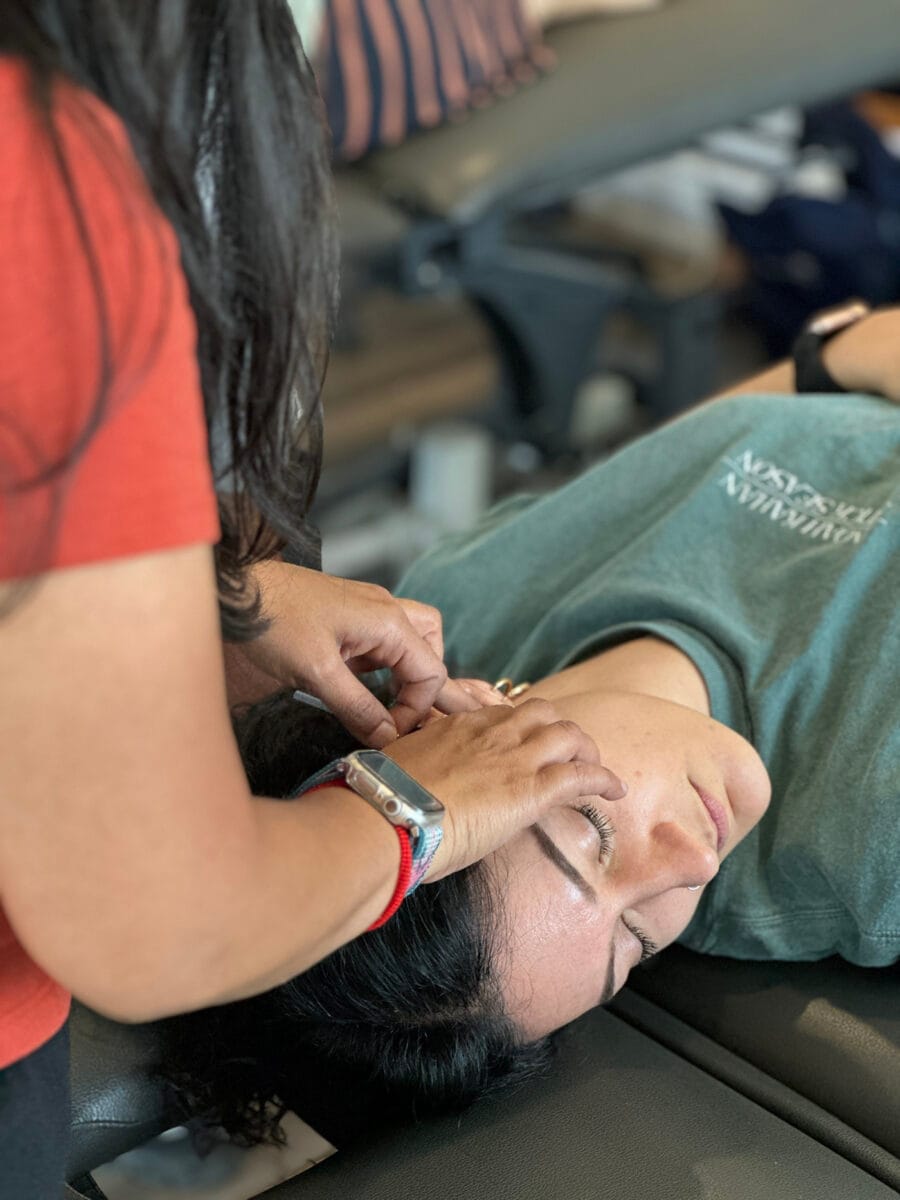
FAQs About Physiotherapy for Headaches and Migraines
Can physiotherapy really help with headaches and migraines?
Yes, physiotherapy in Etobicoke offers a holistic treatment plan that addresses the underlying musculoskeletal causes of headaches and migraines, providing relief and helping to prevent future episodes.
How many physiotherapy sessions will I need?
The number of sessions varies based on the severity of your condition and how well your body responds to treatment. Most patients start to notice significant improvements within 4-6 sessions, but a more personalized plan will be created during your assessment.
Do I need a doctor’s referral to see a physiotherapist?
In most cases, you do not need a doctor’s referral to start physiotherapy in Etobicoke for headaches or migraines. However, it’s always a good idea to check with your insurance company.
What can I expect during my first physiotherapy session?
During your initial visit, the physiotherapist will perform a comprehensive assessment, reviewing your medical history, posture, and muscle function. Based on the findings, a tailored treatment plan will be designed to target your specific symptoms.
Headaches and migraines are often a result of underlying musculoskeletal problems, poor posture, and stress. A holistic approach to physiotherapy in Etobicoke not only alleviates the symptoms but also addresses the root causes, offering long-term relief. By working with a trained physiotherapist, you can significantly reduce the frequency and intensity of your headaches and enjoy a higher quality of life.
If you’re tired of dealing with chronic headaches or migraines, consider physiotherapy in Etobicoke as a natural and effective solution to your pain. Reach out to a qualified physiotherapist to begin your journey toward better health and wellness today.
Understanding the Pelvic Floor and Bladder Health
The pelvic floor consists of a group of muscles that support the bladder, bowel, and uterus (in women). These muscles are responsible for controlling urination, bowel movements, and sexual function. When weakened, common issues such as incontinence, pelvic organ prolapse, and sexual dysfunction can arise. Understanding the role of these muscles is the first step toward strengthening them.
Strengthening you pelvic floor can lead to a stress-free lifestyle. Schedule an appointment with one of the pelvic health physiotherapists at Triangle Physiotherapy.
Key functions of the Pelvic Floor:
- Support of pelvic organs
- Control of bladder and bowel movements
- Sexual health and satisfaction

Benefits of Strengthening the Pelvic Floor
By keeping your pelvic floor muscles strong, you can experience several benefits beyond preventing common issues like incontinence. Some of these include:
- Enhanced bladder control: Strong muscles prevent leakage during activities like sneezing, laughing, or exercising.
- Better posture: The pelvic floor is connected to core muscles, and strengthening it can improve your overall posture.
- Improved sexual function: Strengthening the pelvic muscles can lead to better sexual sensations and enhanced satisfaction.
- Postpartum recovery: New mothers can benefit from a stronger pelvic floor to regain muscle strength after childbirth.
Lifestyle Changes for Pelvic Health

Incorporating small but impactful changes in your daily routine can go a long way in improving pelvic floor and bladder health. Here are a few simple yet effective lifestyle adjustments:
- Stay hydrated but mindful of fluids: Drink plenty of water throughout the day, but reduce intake of caffeinated or carbonated drinks that can irritate the bladder.
- Maintain a healthy weight: Excess weight puts pressure on the pelvic floor, weakening it over time. Maintaining a healthy BMI can reduce strain.
- Eat a fiber-rich diet: Consuming enough fiber prevents constipation, which can stress the pelvic floor.
- Quit smoking: Chronic coughing caused by smoking weakens the pelvic floor muscles over time.
Strengthening your pelvic floor and bladder is a journey that requires consistency and dedication. By incorporating simple exercises, making mindful lifestyle changes, and considering professional or holistic support, you can enjoy better control, confidence, and overall well-being. Remember, prevention is always better than cure, so taking steps to support your pelvic health now will benefit you in the long run.
This lifestyle guide offers a comprehensive approach to strengthening your pelvic floor and bladder. By following these tips and making small adjustments, you’ll be well on your way to a healthier and stronger pelvic floor.
Contact us today to book an appointment with one of our pelvic health physiotherapists at either of our 8 locations and get your recovery journey started.
Chronic pain, a persistent discomfort that lasts for more than three months, can significantly impact quality of life. Unlike acute pain, which typically results from an injury and subsides as the body heals, chronic pain persists for months or even years, often without a clear cause.
Effective management requires a multifaceted approach, including understanding the condition, seeking professional help, and incorporating lifestyle changes.
Understanding Chronic Pain
Chronic pain is often a complex issue with various underlying causes, such as injuries, illnesses, or neurological conditions. It can be a debilitating experience, leading to emotional distress, sleep disturbances, and social isolation. While there may not be a cure, effective management strategies can help individuals cope and improve their overall well-being.
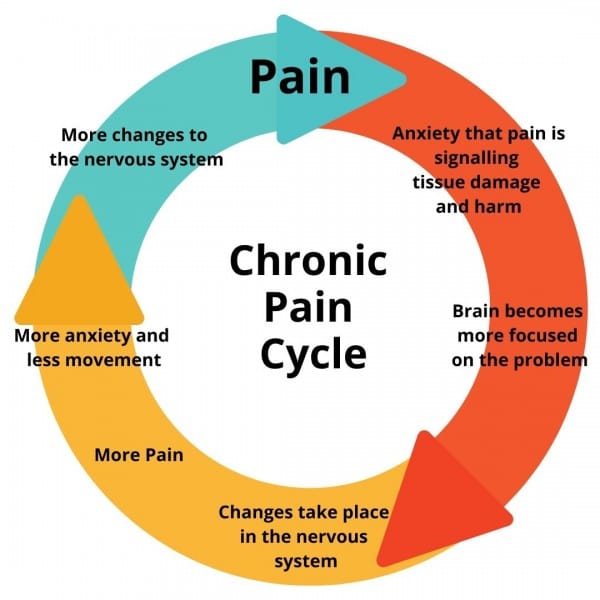
Picture Credit: Capital Area Physical Therapy and Wellness
The pain cycle refers to the self-perpetuating loop in which chronic pain leads to emotional, psychological, and physical responses that, in turn, intensify or prolong the pain. This cycle is common in individuals dealing with long-term pain and can be difficult to break without a comprehensive management plan.
Common Types of Chronic Pain:
- Lower Back Pain: Often caused by issues like herniated discs or spinal conditions.
- Arthritis Pain: Inflammation in the joints can cause persistent discomfort.
- Neuropathic Pain: This type of pain results from nerve damage, often felt as a burning or tingling sensation.
- Headaches and Migraines: Chronic headaches can disrupt daily life and often require specialized treatments.
- Fibromyalgia: A condition that causes widespread muscle pain and tenderness, often accompanied by fatigue.
Causes of Chronic Pain
Chronic pain can stem from a variety of causes, and sometimes, the exact cause remains unknown. Here are some common sources:
- Injuries: Past injuries, even when healed, can leave behind lingering pain.
- Medical Conditions: Diseases like arthritis, diabetes, and fibromyalgia are known to cause chronic pain.
- Nerve Damage: Neuropathic pain often arises from nerve injury or damage, such as after surgery or trauma.
- Inflammation: Conditions that cause inflammation, such as autoimmune diseases, can result in long-lasting pain.
- Psychological Factors: Stress, anxiety, and depression can exacerbate or even trigger chronic pain.
The Importance of Physiotherapy for Chronic Pain
Physiotherapy plays a crucial role in chronic pain management. A qualified physiotherapist can assess the root cause of the pain, develop a personalized treatment plan, and provide guidance on exercises and techniques to alleviate discomfort and improve function. Through targeted interventions, physiotherapy can help individuals regain strength, flexibility, and mobility, ultimately reducing pain and enhancing quality of life.
Managing Chronic Pain: Treatment Options
While chronic pain may not always be curable, it is manageable. A combination of therapies often yields the best results. Below are common methods used to treat and manage chronic pain:
1. Medications:
- Over-the-counter Pain Relievers: Nonsteroidal anti-inflammatory drugs (NSAIDs) like ibuprofen or acetaminophen are often the first line of defense.
- Prescription Medications: In more severe cases, doctors may prescribe opioids, muscle relaxants, or antidepressants that also help relieve pain.
- Topical Treatments: Creams and patches containing pain-relief ingredients can be applied directly to the skin to ease localized pain.
2. Physiotherapy:
- Physiotherapy aims to strengthen muscles, improve flexibility, and reduce pain through movement. A tailored exercise plan can help prevent stiffness and alleviate chronic pain.
3. Cognitive Behavioral Therapy (CBT):
- Chronic pain can have a significant psychological impact. CBT helps patients manage their pain by changing the way they perceive and react to it. This therapy is also useful for dealing with anxiety and depression related to chronic pain.
4. Alternative Therapies:
- Acupuncture: This traditional Chinese medicine technique involves inserting thin needles into specific points of the body to reduce pain.
- Massage Therapy: Gentle massage can help relax muscles and reduce pain in some cases.
- Yoga and Meditation: Mind-body practices like yoga and meditation can help reduce stress, improve flexibility, and alleviate pain.
5. Lifestyle Changes:
While chronic pain can be difficult to prevent entirely, adopting healthy lifestyle habits can significantly reduce the risk and severity of symptoms. Regular exercise, a balanced diet, adequate sleep, and stress management techniques are essential components of a comprehensive approach. By addressing underlying health conditions and making positive lifestyle choices, individuals can improve their overall resilience and reduce the impact of chronic pain
For more information on how to reduce or manage chronic pain with physiotherapy, contact us at 416.207.9911 to make an appointment at one of our physiotherapy clinics:
Shoulder pain is a common issue that can affect anyone, whether you’re an athlete, a desk worker, or someone engaging in daily activities. Understanding the causes, prevention strategies, and effective treatments can help you manage this discomfort and improve your quality of life.
Thankfully, the physiotherapists and chiropractors at Triangle Physiotherapy are well-versed in diagnosing and treating shoulder conditions and also making sure you know what to do to prevent future recurrences.
Lets dive into a detailed look into shoulder pain!
Understanding Shoulder Pain
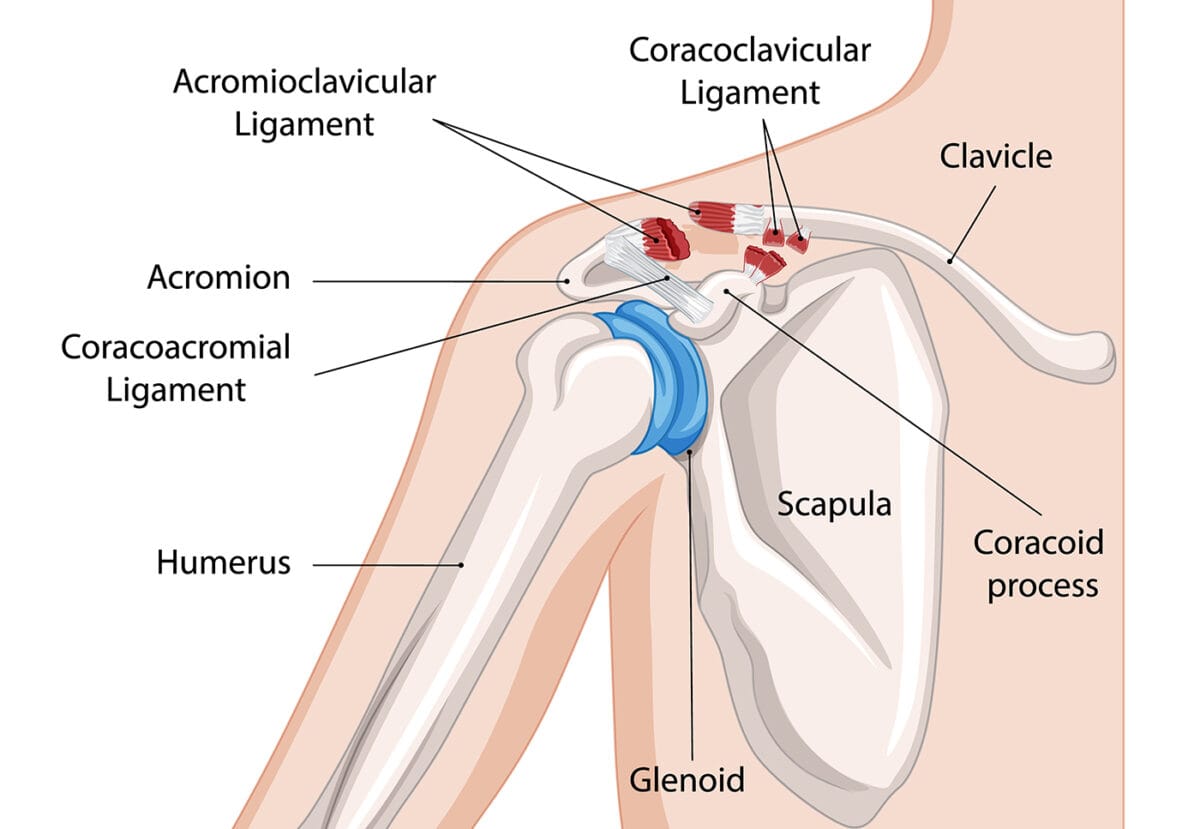
Shoulder pain can arise from a variety of sources, including injuries, overuse, and underlying medical conditions. Common causes include rotator cuff injuries, tendonitis, bursitis, arthritis, and referred pain from the neck or back. The shoulder is a complex joint with a wide range of motion, making it susceptible to strain and injury.
Prevention
Preventing shoulder pain involves proactive measures to protect your joints and maintain strength and flexibility. Here are some key strategies:
- Proper Posture: Maintain good posture while sitting and standing to reduce strain on your shoulders. Be mindful of your alignment, especially when using computers or mobile devices.
- Strength Training: Regularly engage in strength training exercises to support shoulder stability. Focus on the rotator cuff and shoulder blade muscles.
- Warm-Up Before Activity: Always warm up before engaging in sports or physical activities to prepare your muscles and joints.
Importance of Physiotherapy for Shoulder Pain
Physiotherapy is essential in diagnosing and treating shoulder pain. A physiotherapist can create a personalized treatment plan that includes exercises to strengthen the shoulder muscles, improve flexibility, and promote healing. They can also provide manual therapy and modalities like ultrasound or electrical stimulation to alleviate pain. Early intervention can prevent chronic issues and aid recovery.
Neuromuscular Exercises for Pain
Neuromuscular exercises focus on improving coordination and strength, which are crucial for shoulder health. Effective neuromuscular exercises for shoulder pain include:
- External Rotations: This exercise targets the rotator cuff, enhancing stability.
- Scapular Retractions: Strengthens the muscles around the shoulder blades, promoting better posture.
- Wall Angels: Improves shoulder mobility and encourages proper movement patterns.
Progressive Resistance Training
Incorporating progressive resistance training into your fitness routine can greatly benefit shoulder health. Gradually increasing the weights you lift helps build strength and endurance in the shoulder muscles. Focus on compound movements like overhead presses and rows, ensuring you maintain proper form to avoid further injury.
Incorporating Mobility into Your Daily Routine
Mobility exercises enhance flexibility and range of motion, crucial for preventing shoulder pain. Simple stretches like doorway stretches, cross-body arm stretches, and shoulder rolls can make a significant difference. Incorporate these stretches into your daily routine, perhaps during breaks or before bed, to keep your shoulders flexible and reduce tightness.
Tips for Safely Performing Exercises
Safety should always be your priority when exercising, especially if you’re dealing with shoulder pain. Here are some tips to keep in mind:
- Warm-Up: Always begin with a gentle warm-up to prepare your muscles.
- Listen to Your Body: If any movement causes pain, stop immediately and reassess.
- Use Proper Technique: Focus on form rather than weight to prevent injuries.
Consult Professionals: Work with a physiotherapist if you’re unsure about your exercises or recovering from an injury.
Shoulder pain can be a frustrating condition, but understanding its causes and implementing preventive measures can lead to relief. Always prioritize safety and seek professional guidance when needed. With the right approach, you can manage and reduce shoulder pain, allowing you to return to your favorite activities and enjoy a healthier lifestyle.
We understand that life can get busy but don’t forget to prioritize your health. Book an appointment to get that shoulder checked out at any one of our 8 locations.
Sources:
https://www.physio-pedia.com/Evidence_Based_Interventions_for_Shoulder_Pain
Foot pain is a common complaint that can significantly impact our daily lives. From discomfort while walking to more severe conditions, understanding the underlying causes can help us prevent and manage this issue effectively. In this blog post, we’ll explore the most common reasons for foot pain and discuss effective strategies for prevention and treatment.
The team of physiotherapists at Triangle Physiotherapy have the training and expertise to diagnose the problem and help you a customized treatment plan and get your recovery journey started.
Common Causes of Foot Pain

- Plantar Fasciitis: This condition occurs due to inflammation of the plantar fascia, a tissue that connects the heel bone to the toes. Symptoms often include sharp pain in the heel, especially upon waking up.
- Achilles Tendinitis: The Achilles tendon, the largest tendon in the body, can become inflamed due to overuse, improper footwear, or sudden increases in activity. This leads to pain and stiffness in the back of the heel.
- Stress Fractures: These tiny breaks in bones can occur due to repetitive stress or sudden increases in activity. Common locations for stress fractures in the foot include the metatarsals and the navicular bone.
- Bunions: Bunions are bony bumps that form at the base of the big toe, often causing pain and discomfort. They can be caused by genetic factors, tight-fitting shoes, or biomechanical issues.
- Neuromas: These are benign growths that occur between the toes, often causing a burning or tingling sensation. They are more common in women and can be caused by high-heeled shoes or other factors.
Prevention of Foot Pain

- Proper Footwear: Choose shoes that fit well and provide adequate support and cushioning. Avoid wearing high heels or shoes that are too tight or too loose.
- Stretching and Strengthening: Regular stretching exercises can help to improve flexibility and reduce the risk of injury. Strengthening exercises can help to build the muscles that support the feet and ankles.
- Maintain a Healthy Weight: Excess weight can put additional stress on the feet, increasing the risk of pain and injury.
- Take Breaks: If you have a job that requires you to stand or walk for long periods, take regular breaks to rest your feet.
- Address Biomechanical Issues: If you have underlying biomechanical problems, such as flat feet or high arches, consider orthotics or other interventions to correct these issues.
The Importance of Physiotherapy for Foot Pain
A physiotherapist can play a crucial role in diagnosing and treating foot pain. They can assess your condition, provide targeted exercises and stretches, and recommend appropriate footwear or orthotics. Physiotherapy can help to reduce pain, improve mobility, and prevent future injuries.
Neuromuscular Exercises for Foot Pain
Neuromuscular exercises focus on improving the coordination between your muscles and nerves, which can help to stabilize your feet and ankles. Examples of neuromuscular exercises include balance exercises, proprioceptive training, and plyometric drills.
Progressive Resistance Exercises for Foot Pain
Progressive resistance exercises gradually increase the strength and endurance of the muscles in your feet and ankles. This can help to improve stability and reduce the risk of injury. Examples of resistance exercises include calf raises, toe curls, and resistance band exercises.
Incorporating Mobility into Daily Life
Mobility is essential for maintaining healthy feet and ankles. Incorporate mobility exercises into your daily routine, such as walking, swimming, or yoga. These activities can help to improve flexibility, strength, and overall foot health.
Tips for Safety
- Listen to Your Body: If you experience pain or discomfort, take a break and rest.
- Avoid Overdoing It: Gradually increase the intensity and duration of your activities to avoid injury.
- Seek Professional Help: If you have persistent foot pain or concerns, consult with a physiotherapist to get it resolved.
Locations of Triangle Physiotherapy Clinics:
Back pain is a common complaint that affects millions of people worldwide. It can range from a dull ache to sharp, debilitating pain. Understanding the causes, prevention strategies, and effective treatments is essential for managing this condition.
Understanding Back Pain
Back pain can arise from various sources, including poor posture, muscle strains, or injuries. Other factors such as age, obesity, and sedentary lifestyles can also contribute. Often, back pain stems from the muscles, ligaments, or discs in the spine becoming strained or injured. In some cases, underlying conditions like arthritis or herniated discs can cause chronic pain.
The good news is that the physiotherapists at Triangle Physiotherapy can help you manage back pain and prevent recurrence.
Importance of Physiotherapy when you have Back Pain
Physiotherapy plays a crucial role in both treating and preventing back pain. A physiotherapist can assess your condition, provide tailored exercises, and educate you on proper movement techniques. They can also help manage pain through modalities like heat therapy, ultrasound, or electrical stimulation. Early intervention can prevent the escalation of back issues and promote a quicker recovery.
What can I do if I have Back Pain?
The best thing you can do for any type of pain is to stay active. Whether it is walking, running or yoga, find an activity that keeps you moving.
Neuromuscular Exercises for Pain
Neuromuscular exercises focus on improving the communication between your brain and muscles, enhancing coordination and strength. These exercises can be particularly effective for back pain by stabilizing the spine and improving posture. Common neuromuscular exercises include:
- Bird-Dog: This exercise enhances core stability while promoting balance.

- Plank: Planks engage the entire core, supporting your back muscles.

- Bridge: This helps strengthen the glutes and lower back, essential for overall stability.

Progressive Resistance Training
Incorporating progressive resistance training into your routine can significantly reduce back pain. This type of training involves gradually increasing the weights you lift, which helps build muscle strength and endurance. Stronger muscles support your spine better, reducing the likelihood of injury. Focus on exercises that target your back, core, and lower body, such as deadlifts and rows, while ensuring you maintain proper form.
Incorporating Mobility into Your Daily Routine
Mobility exercises enhance flexibility and range of motion, which can alleviate back pain. Simple stretches like hamstring stretches, spinal twists, and hip flexor stretches can make a significant difference. Incorporate these into your daily routine—perhaps after waking up or during breaks at work. Mobility should be part of your lifestyle, not just an exercise program.
Tips for Safely Performing Exercises
Safety is paramount when exercising, especially if you’re managing back pain. Here are some tips to keep in mind:
- Warm-Up: Always start with a warm-up to prepare your muscles.
- Listen to Your Body: If an exercise causes pain, stop immediately.
- Use Proper Form: Focus on technique over weight to prevent injuries.
- Consult Professionals: Work with a trainer or physiotherapist, especially if you’re new to exercise or recovering from an injury.
Prevention
Preventing back pain is often more effective than treating it after it occurs. Here are some key strategies to help you avoid back issues:
- Maintain Good Posture: Be mindful of how you sit, stand, and lift objects. Keeping your back straight and your shoulders back can significantly reduce strain on your spine.
- Stay Active: Regular physical activity strengthens your back and core muscles, providing better support for your spine.
- Ergonomic Workspace: If you work at a desk, ensure your workstation is set up to promote good posture. Use chairs that offer proper lumbar support and position your computer screen at eye level.
Back pain can be a challenging and frustrating condition, but understanding its causes and implementing preventive measures can lead to relief. Always prioritize safety and seek professional guidance when needed. With the right approach, you can manage and reduce back pain, leading to a healthier, more active lifestyle.
Read also: Rehabilitation for Low Back Pain – Source: Physio Pedia









